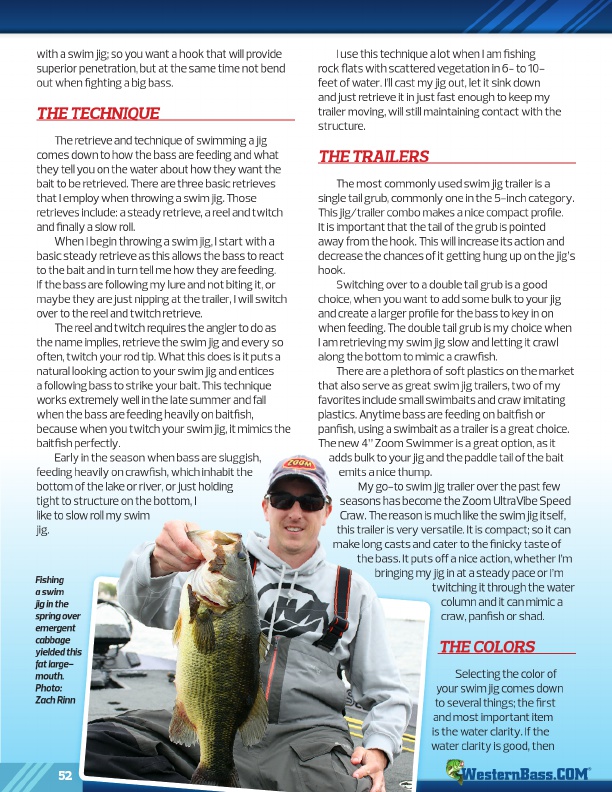
with a swim jig; so you want a hook that will provide superior penetration, but at the same time not bend out when fighting a big bass.
THE TECHNIQUE
The retrieve and technique of swimming a jig comes down to how the bass are feeding and what they tell you on the water about how they want the bait to be retrieved. There are three basic retrieves that I employ when throwing a swim jig. Those retrieves include: a steady retrieve, a reel and twitch and finally a slow roll.
When I begin throwing a swim jig, I start with a basic steady retrieve as this allows the bass to react to the bait and in turn tell me how they are feeding. If the bass are following my lure and not biting it, or maybe they are just nipping at the trailer, I will switch over to the reel and twitch retrieve.
The reel and twitch requires the angler to do as the name implies, retrieve the swim jig and every so often, twitch your rod tip. What this does is it puts a natural looking action to your swim jig and entices a following bass to strike your bait. This technique works extremely well in the late summer and fall when the bass are feeding heavily on baitfish, because when you twitch your swim jig, it mimics the baitfish perfectly.
Early in the season when bass are sluggish, feeding heavily on crawfish, which inhabit the bottom of the lake or river, or just holding tight to structure on the bottom, I like to slow roll my swim jig.
Fishing a swim jig in the spring over emergent cabbage yielded this fat large- mouth. Photo: Zach Rinn
52
I use this technique a lot when I am fishing rock flats with scattered vegetation in 6- to 10- feet of water. I’ll cast my jig out, let it sink down and just retrieve it in just fast enough to keep my trailer moving, will still maintaining contact with the structure.
THE TRAILERS
The most commonly used swim jig trailer is a single tail grub, commonly one in the 5-inch category. This jig/trailer combo makes a nice compact profile. It is important that the tail of the grub is pointed away from the hook. This will increase its action and decrease the chances of it getting hung up on the jig’s hook.
Switching over to a double tail grub is a good choice, when you want to add some bulk to your jig and create a larger profile for the bass to key in on when feeding. The double tail grub is my choice when I am retrieving my swim jig slow and letting it crawl along the bottom to mimic a crawfish.
There are a plethora of soft plastics on the market that also serve as great swim jig trailers, two of my favorites include small swimbaits and craw imitating plastics. Anytime bass are feeding on baitfish or panfish, using a swimbait as a trailer is a great choice. The new 4” Zoom Swimmer is a great option, as it
adds bulk to your jig and the paddle tail of the bait
emits a nice thump.
My go-to swim jig trailer over the past few
seasons has become the Zoom UltraVibe Speed
Craw. The reason is much like the swim jig itself,
this trailer is very versatile. It is compact; so it can
make long casts and cater to the finicky taste of
the bass. It puts off a nice action, whether I’m
bringing my jig in at a steady pace or I’m
twitching it through the water
column and it can mimic a
craw, panfish or shad.
THE COLORS
Selecting the color of your swim jig comes down to several things; the first and most important item is the water clarity. If the water clarity is good, then
®